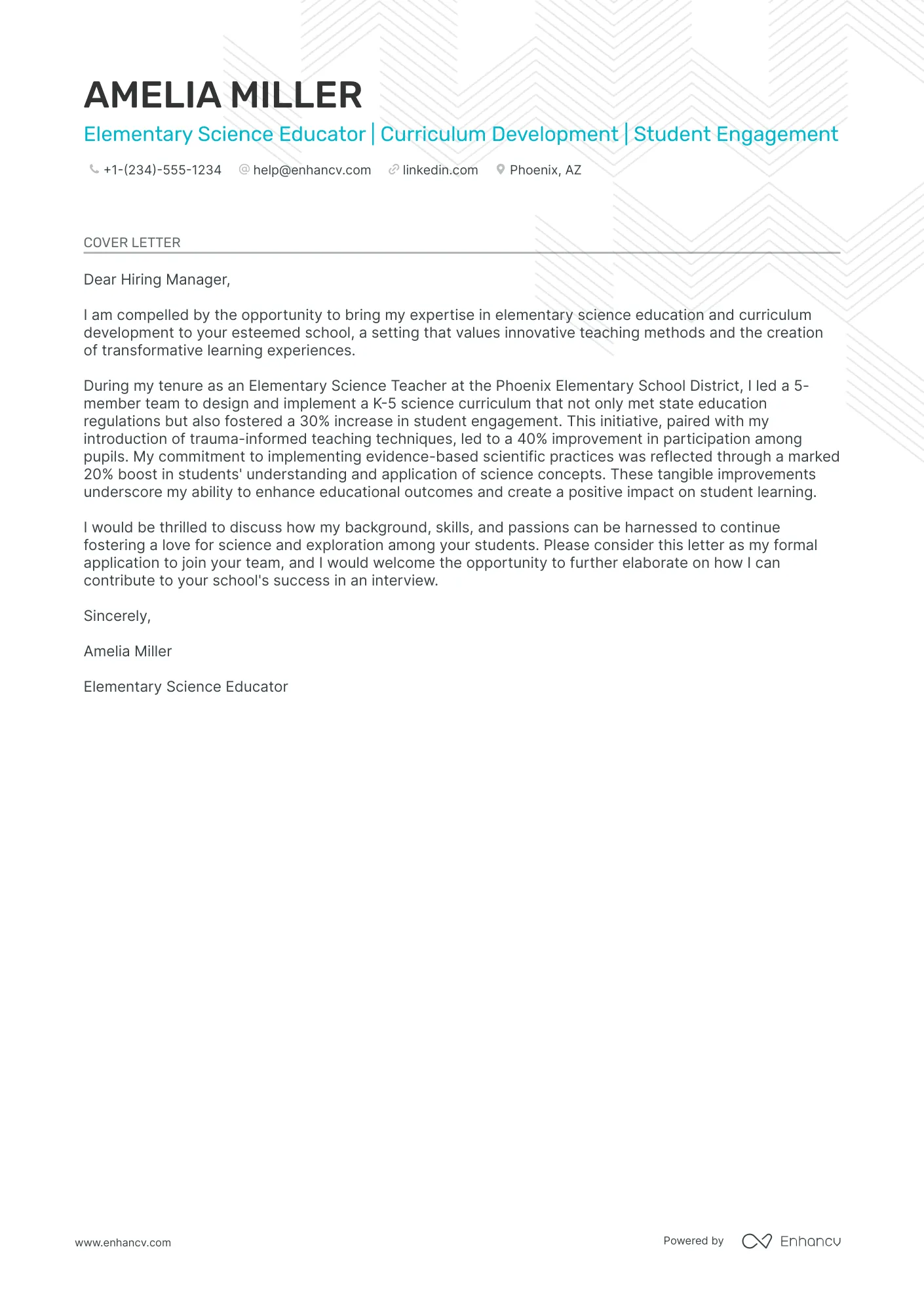Crafting a Compelling Cover Letter
As a new teacher, your cover letter is your first impression on potential employers. It is your opportunity to showcase your skills, passion, and qualifications. A well-crafted cover letter is essential for standing out from the competition and securing your dream teaching position. This guide provides comprehensive insights and examples to help you create a compelling cover letter that grabs attention and highlights your unique strengths. Remember, your cover letter should not just reiterate your resume; it should tell a story about who you are as an educator and why you are the perfect fit for the role. The key is to present yourself as a passionate, knowledgeable, and dedicated individual ready to contribute to a positive learning environment.
Understanding the Purpose of a Cover Letter
The primary purpose of a cover letter is to introduce yourself to the hiring committee and explain why you are the ideal candidate for the position. It provides a platform to express your enthusiasm for the role and the school district, and it allows you to elaborate on your qualifications in a way that a resume alone cannot. A cover letter also demonstrates your communication skills, organizational abilities, and attention to detail. It should showcase your personality, teaching philosophy, and your understanding of the school’s values. A well-written cover letter is an essential tool in your job search arsenal, setting the stage for a successful application.
Showcasing Your Skills and Experience
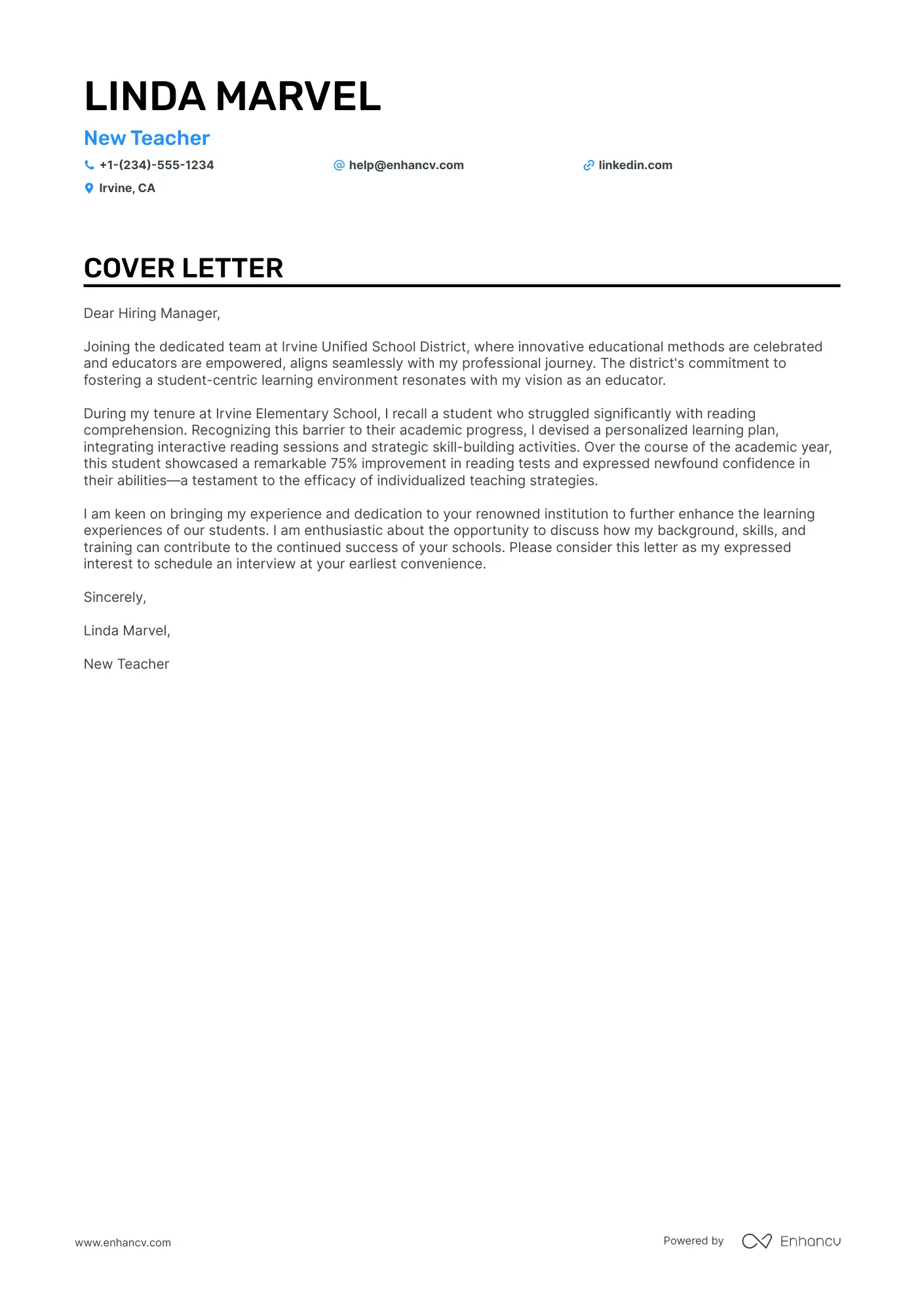
Your cover letter is the perfect place to highlight the skills and experiences that make you a strong candidate. Focus on relevant skills that align with the job description, such as classroom management, lesson planning, curriculum development, and student assessment. Use concrete examples to illustrate how you have successfully applied these skills in the past. For instance, describe a time you used a specific teaching method to engage students or how you implemented a classroom management strategy that improved student behavior. Always quantify your achievements whenever possible, such as ‘increased student test scores by 15%’ or ‘implemented a new literacy program that benefited 50 students’. This will demonstrate your effectiveness and ability to achieve measurable results.
Highlighting Relevant Qualifications
In addition to showcasing your skills, your cover letter should emphasize your relevant qualifications, including your education, certifications, and any specialized training you have received. Mention your degree, major, and any honors or awards you have earned. Be sure to highlight any certifications, such as a teaching license or special education endorsement. If you have completed any professional development courses or workshops, be sure to include them. Tailor your qualifications to match the specific requirements of the job you are applying for. Research the school’s specific needs and highlight how your qualifications meet those needs, demonstrating that you are a well-suited and prepared candidate.
Tailoring Your Cover Letter
One of the most critical aspects of a successful cover letter is tailoring it to each specific job application. Avoid using a generic cover letter for all positions. Instead, customize each letter to reflect the unique requirements of the school and the role. Start by carefully reviewing the job description and identifying the key skills, qualifications, and experiences the employer is seeking. Then, use these keywords and phrases throughout your cover letter to demonstrate how your background aligns with their needs. Mention the school’s mission, values, and any specific programs or initiatives that resonate with you. This shows you’ve done your research and genuinely want to be a part of their community.
Researching the School and Position
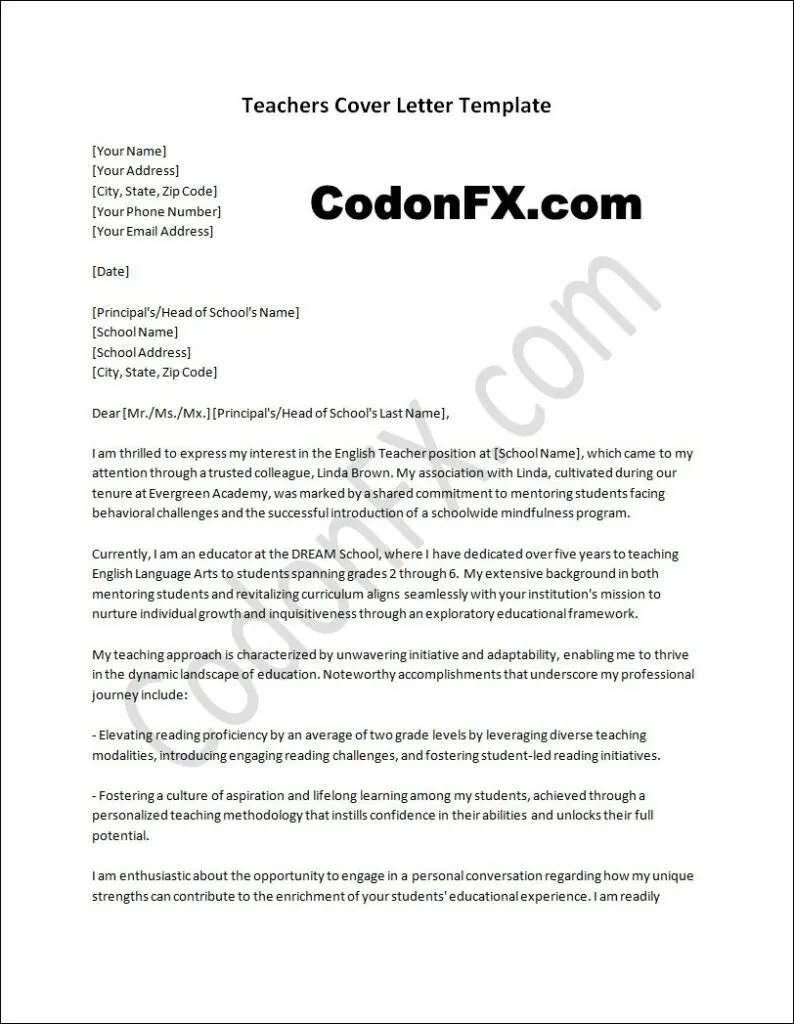
Before you begin writing your cover letter, thoroughly research the school and the specific teaching position. Visit the school’s website to learn about its mission, values, and programs. Read any recent news articles or press releases about the school to understand its current priorities and challenges. If possible, connect with current teachers or staff members to get insights into the school’s culture and environment. This research will help you tailor your cover letter to the school’s specific needs and show the hiring committee that you are genuinely interested in the position and prepared to contribute to their community. Use specific examples and language from your research to demonstrate your understanding and interest in the school.
Formatting and Structure
A well-formatted and structured cover letter is crucial for making a positive impression. Use a professional font, such as Times New Roman or Arial, and maintain consistent font sizes and margins throughout the document. Your cover letter should typically be one page in length and include the following sections heading, greeting, opening paragraph, body paragraphs, closing paragraph, and a formal sign-off. Keep paragraphs concise and focused, using clear and direct language. Ensure that your cover letter is free of grammatical errors and typos. Proofread your letter multiple times, and consider asking a friend or colleague to review it as well. A polished cover letter reflects your professionalism and attention to detail.
Essential Cover Letter Components
Your cover letter should include several key components to effectively communicate your qualifications and interest. The heading should include your contact information (name, address, phone number, and email address) and the date. The greeting should address the hiring manager by name, if possible, using their title (e.g., ‘Dear Mr. Smith’). The opening paragraph should capture the reader’s attention and state the position you are applying for and where you found the job posting. The body paragraphs should provide detailed examples of your skills, experiences, and qualifications. The closing paragraph should express your enthusiasm for the opportunity and a call to action, such as requesting an interview. Finally, include a formal sign-off, such as ‘Sincerely’ or ‘Respectfully,’ followed by your typed name.
Writing a Strong Opening
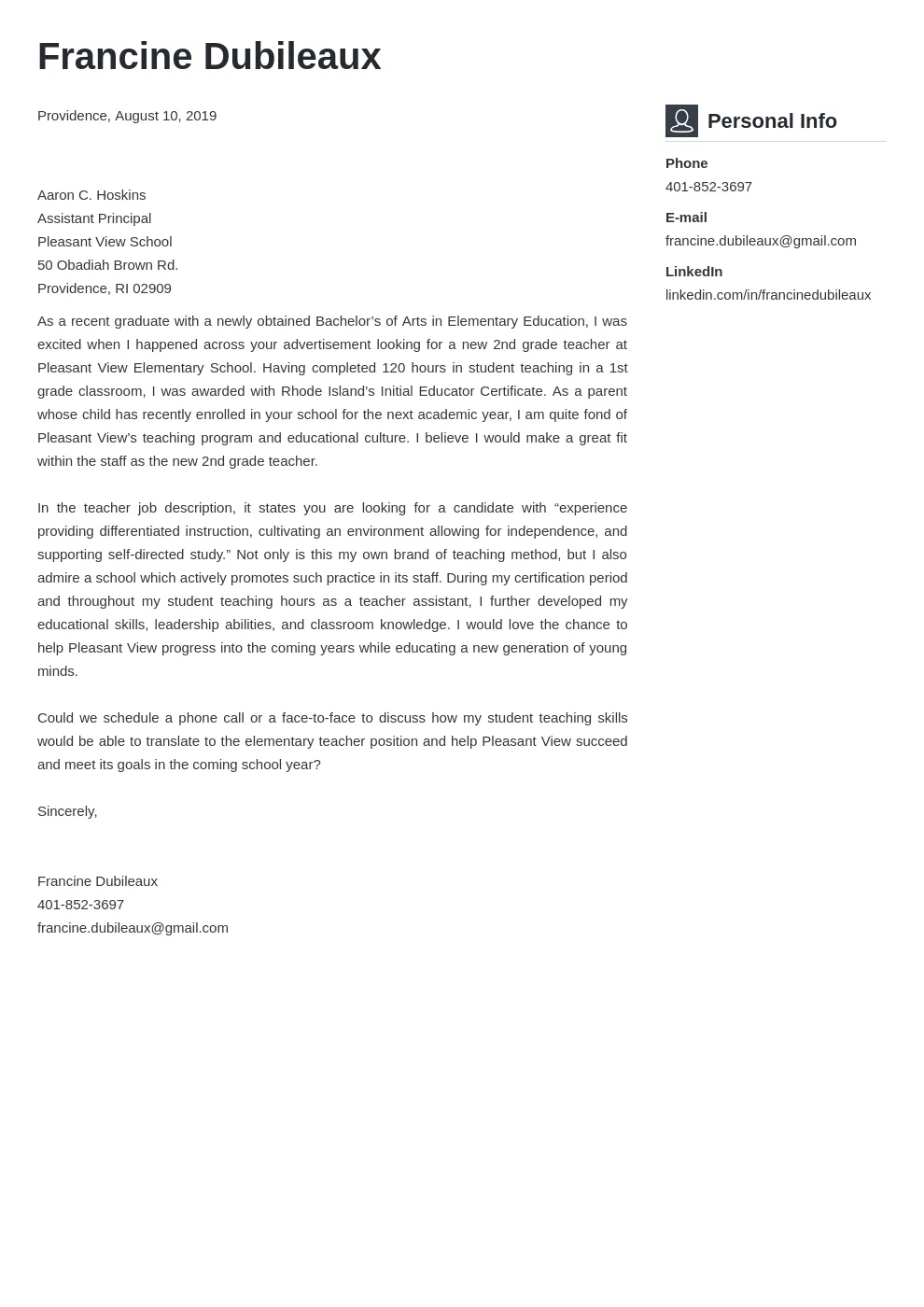
The opening paragraph of your cover letter is your first opportunity to grab the reader’s attention. Begin by stating the position you are applying for and where you saw the job posting. Then, briefly introduce yourself and highlight your key skills or experiences. Instead of simply stating what you are applying for, try to make your opening more engaging. For example, you could share a brief anecdote about your passion for teaching or express your excitement about the school’s mission. A strong opening paragraph sets the tone for the rest of your letter and encourages the hiring committee to continue reading. The goal is to make a positive first impression and pique their interest in learning more about you.
Detailing Your Teaching Philosophy
Your cover letter is an excellent place to detail your teaching philosophy. Briefly explain your beliefs about education, your approach to teaching, and your goals for your students. Describe how you create a positive and inclusive classroom environment, foster student engagement, and promote critical thinking skills. Mention any specific teaching methods or strategies you use, such as differentiated instruction, project-based learning, or collaborative activities. Demonstrate your commitment to student success and your ability to create a supportive and challenging learning environment. Providing insight into your teaching philosophy helps the hiring committee understand your approach to education and assess how well you align with the school’s values and goals.
Demonstrating Your Classroom Management Abilities
Classroom management is a critical aspect of teaching, and it is important to demonstrate your abilities in this area in your cover letter. Describe your approach to creating a structured and disciplined classroom environment. Mention specific strategies you use to establish clear expectations, build positive relationships with students, and address disruptive behavior. Provide examples of how you have successfully managed a classroom in the past, such as how you have implemented a particular management system. Highlight your ability to create a respectful and supportive learning environment where students feel safe, engaged, and motivated to learn. Showing your competence in classroom management is important for assuring the hiring committee of your ability to maintain order and create a productive learning atmosphere.
Emphasizing Your Relevant Experiences
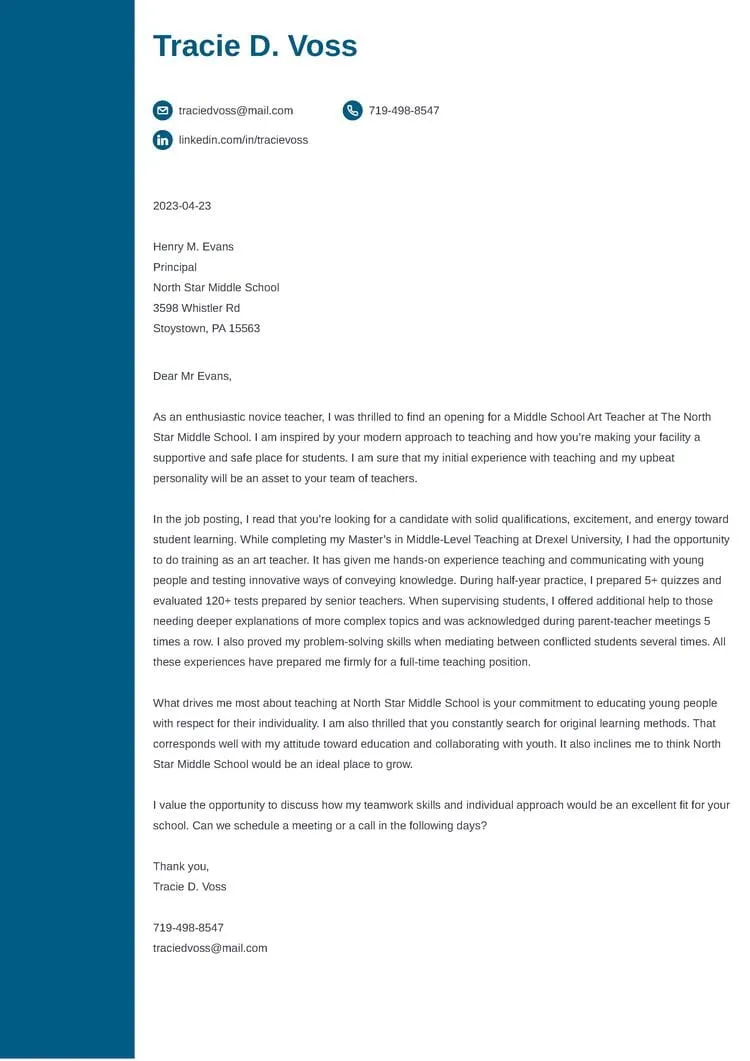
Use your cover letter to emphasize your relevant experiences, such as student teaching, internships, volunteer work, or other teaching-related activities. Provide specific examples of how you have applied your skills and knowledge in these experiences. Describe your responsibilities, the challenges you faced, and the outcomes you achieved. If you have experience working with specific age groups, subjects, or student populations, be sure to mention it. Quantify your achievements whenever possible. For example, ‘Successfully managed a classroom of 25 students during my student teaching experience, resulting in improved student engagement and test scores.’ Highlighting your relevant experience shows the hiring committee that you have practical experience and are prepared for the role.
Showcasing Your Achievements
Your cover letter is a perfect opportunity to showcase your achievements as an educator. Highlight any awards, recognitions, or other accomplishments that demonstrate your skills and dedication. If you have received any teaching awards, student achievement awards, or other accolades, be sure to include them. Mention any successful projects or initiatives you have implemented. Quantify your achievements whenever possible using metrics to show your impact. For example, ‘Implemented a new reading program that improved student reading comprehension scores by 20%.’ Highlighting your achievements will help you stand out from the competition and demonstrate your ability to make a positive impact on student learning.
Structuring the Body of Your Letter
The body of your cover letter should be structured logically to present your qualifications and experiences effectively. Use clear and concise paragraphs, each focusing on a specific aspect of your candidacy. Organize your content in a way that is easy for the hiring committee to read and understand. Consider using the STAR method (Situation, Task, Action, Result) to structure your examples, which helps you provide details about your accomplishments. Begin each paragraph with a topic sentence that clearly introduces the main idea, and support your statements with specific examples and evidence. Proofread your letter carefully to ensure that the structure is logical, and the writing is clear and coherent.
Using Action Verbs and Keywords
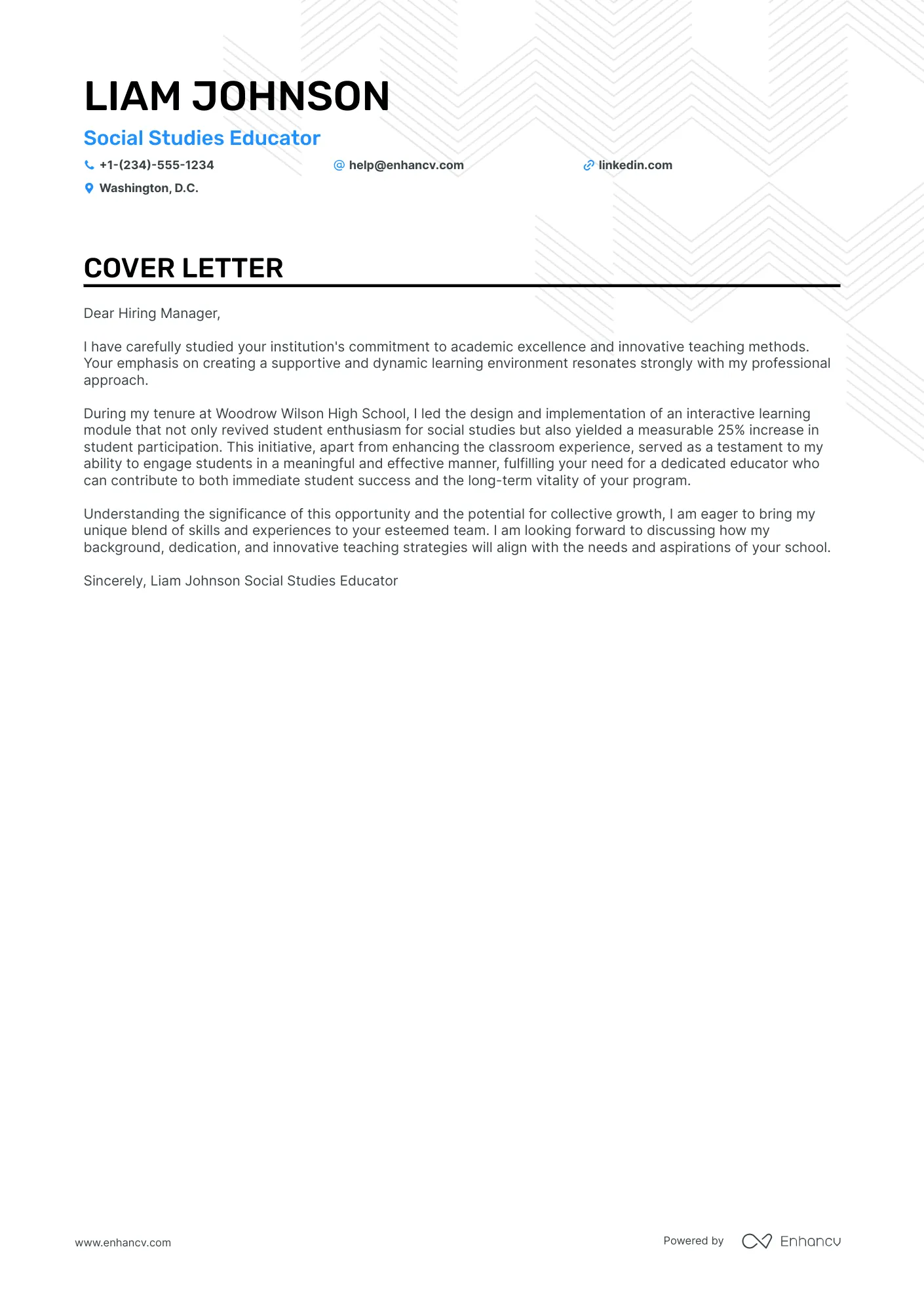
Using strong action verbs and relevant keywords is crucial for making your cover letter stand out. Start each sentence with an action verb to describe your accomplishments and responsibilities. Use keywords from the job description to demonstrate that you meet the requirements of the position. Some examples of action verbs for teachers include developed, implemented, assessed, mentored, created, and facilitated. Incorporate keywords such as ‘classroom management,’ ’lesson planning,’ ‘differentiated instruction,’ or any other terms that are relevant to the job description. These keywords will help your cover letter get noticed by the hiring committee and increase your chances of getting an interview.
Writing a Powerful Closing
The closing paragraph of your cover letter should leave a lasting impression on the reader. Express your enthusiasm for the opportunity and reiterate your interest in the position. Thank the hiring committee for their time and consideration. Include a call to action, such as requesting an interview and providing your contact information. Make sure that your closing paragraph is confident and professional. Consider adding a personal touch by mentioning something specific about the school or the role that excites you. A well-written closing paragraph can reinforce your interest and increase your chances of being selected for an interview.
Expressing Enthusiasm and Interest
Throughout your cover letter, it is essential to express your enthusiasm and interest in the position and the school. Let your passion for teaching shine through by using positive and engaging language. Show that you have researched the school and are excited about the opportunity to contribute to its mission. Express your commitment to student success and your desire to create a positive and supportive learning environment. A sincere expression of interest and enthusiasm will make you a more appealing candidate. This enthusiasm can be conveyed through your tone, the specific details you share, and the way you connect your skills and experiences to the school’s values and goals.
Making a Strong Call to Action
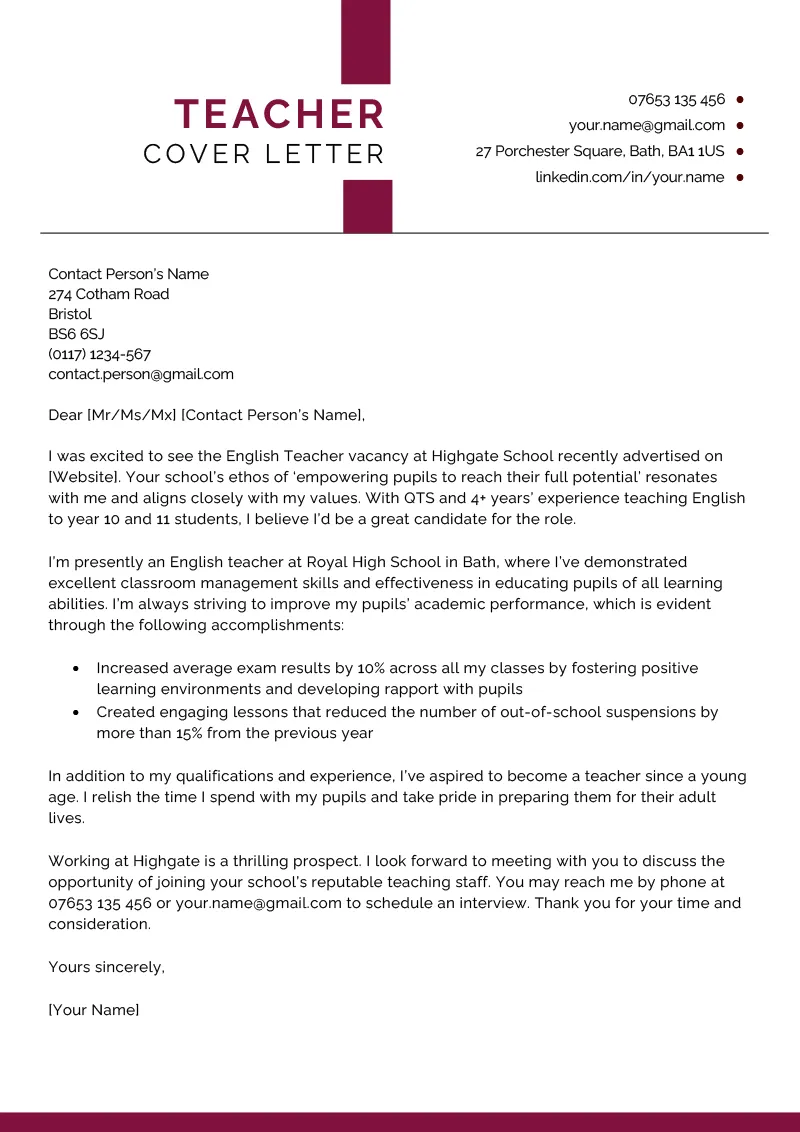
In your closing paragraph, include a strong call to action. This is a direct invitation to the hiring committee to take the next step in the hiring process. Request an interview and provide your contact information again. Be specific and make it easy for them to contact you. For example, ‘I am eager to discuss my qualifications further and would welcome the opportunity to interview for this position. You can reach me at [phone number] or [email address]. Thank you for your time and consideration.’ A clear call to action will increase your chances of receiving a positive response and moving forward in the job application process. Your call to action is your final opportunity to prompt the hiring committee to act on your application.
Examples of Effective Cover Letters
Reviewing examples of effective cover letters is a great way to get inspiration and learn how to structure your letter. Search for cover letter templates and examples online. Look for cover letters from new teachers who have successfully secured teaching positions. Pay attention to the format, language, and content of these examples. Note how they highlight their skills and experiences, and how they tailor their letters to specific positions and schools. While using examples as a guide, be sure to personalize your own cover letter to reflect your unique qualifications and experiences. Avoid simply copying and pasting from a template, and use the examples as a starting point to create a letter that truly represents you.
Cover Letter Example for Elementary School Teacher
For an elementary school teacher cover letter example, focus on your skills in creating a nurturing and engaging learning environment for young children. Highlight your experience with early childhood education and your ability to differentiate instruction to meet the diverse needs of students. Mention any specific programs or strategies you have used to promote literacy, numeracy, and social-emotional development. Tailor your cover letter to the school’s mission, and demonstrate your ability to build positive relationships with students, parents, and colleagues. This cover letter needs to emphasize your enthusiasm and your ability to foster a love of learning in young children. It should also describe your familiarity with age-appropriate teaching methods and curriculum.
Cover Letter Example for Middle School Teacher
A middle school teacher cover letter needs to showcase your ability to work with pre-teen and teenage students. Emphasize your skills in classroom management, lesson planning, and assessment. Highlight your knowledge of the specific subject you will be teaching and your ability to engage students in meaningful learning experiences. Mention any experience you have working with this age group, such as volunteer work or internships. Detail your strategies for motivating students, addressing their unique challenges, and creating a supportive and stimulating learning environment. Your letter should also express your understanding of the developmental needs of middle school students and your ability to foster their academic and social-emotional growth.
Cover Letter Example for High School Teacher
For a high school teacher, your cover letter should reflect your ability to engage older students, manage a complex classroom, and teach a specific subject. Showcase your expertise in lesson planning, curriculum development, and assessment, while also emphasizing your ability to build rapport with high school students. Mention any experience you have, such as internships or volunteer work, and highlight any achievements. Detail your strategies for promoting critical thinking skills, preparing students for college and careers, and fostering a positive classroom atmosphere. Your cover letter should clearly outline your understanding of the needs and challenges of high school students and your plan to create a stimulating and challenging learning environment.
Cover Letter Example for Special Education Teacher
When writing a cover letter for a special education teacher, your letter should focus on your experience with students with diverse learning needs. Highlight your qualifications and the skills you have to create and implement individualized education programs (IEPs). Emphasize your ability to differentiate instruction, manage a diverse classroom, and collaborate with parents, specialists, and other educators. Mention any specialized training or certifications you have, such as a special education endorsement. Describe your experience with different disabilities and your understanding of evidence-based teaching practices. Your cover letter needs to convey your dedication to helping students with special needs reach their full potential, and to your skills in providing a supportive, inclusive, and effective learning environment for every child.
Common Mistakes to Avoid
Avoid common mistakes that can hurt your chances of landing a teaching position. Don’t use generic cover letters; always tailor each letter to the specific job. Avoid typos, grammatical errors, and formatting issues. Do not focus solely on what you want; emphasize what you can offer the school. Do not exceed the one-page limit. Avoid using jargon or overly technical language. Don’t submit a cover letter without proofreading. Refrain from being negative or complaining about previous experiences. By avoiding these common pitfalls, you can increase your chances of creating a cover letter that makes a positive impression and showcases your strengths as a new teacher.
Proofreading and Editing
Proofreading and editing your cover letter is critical for ensuring it is polished, professional, and free of errors. Before submitting your cover letter, carefully review it for any typos, grammatical errors, or formatting inconsistencies. Read your letter aloud to catch any awkward phrasing or unclear sentences. Check the spelling of the school name, the hiring manager’s name, and any other important details. Consider asking a friend, mentor, or career counselor to review your cover letter for feedback. A well-proofread and edited cover letter demonstrates your attention to detail and your commitment to presenting yourself in the best possible light.
Seeking Feedback
Seeking feedback on your cover letter is a valuable step in the job application process. Ask a trusted friend, mentor, career counselor, or experienced teacher to review your cover letter. Provide them with the job description and ask them to assess whether your letter effectively addresses the key requirements and demonstrates your strengths. Be open to their suggestions and willing to make revisions based on their feedback. Asking for feedback can help you identify areas for improvement and ensure that your cover letter is as strong and impactful as possible. This step shows your commitment to improving your application and making a positive impression on potential employers. Don’t be afraid to revise your letter until it’s perfect.
Finalizing and Submitting Your Cover Letter
Before submitting your cover letter, ensure that it is finalized and ready for delivery. Double-check the formatting, grammar, and spelling. Make sure you have personalized the letter to match the job description and the school’s specific needs. Save your cover letter in a professional format, such as PDF, unless the job posting specifies otherwise. Proofread your cover letter one last time before submitting it. Then, submit your cover letter along with your resume. Once you have submitted your cover letter, keep a copy for your records. Be prepared to follow up with the hiring committee if you have not heard back within a reasonable timeframe. By following these steps, you can increase your chances of submitting a compelling cover letter and landing your dream teaching position.
